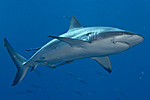|
Undersea Explorer - 19 to 25 August 2006
This is an account of my fourth trip to the Great Barrier Reef and the Coral Sea aboard the Undersea Explorer. The Undersea Explorer mixes research and recreational diving for a truly fantastic experience. It is one of the few, if not the only, vessel that makes regular trips to Osprey Reef in The Coral Sea. For more information about the Undersea Explorer, please see their website at www.undersea.com.au.
This year there was a group of six of us joining the other guests on the boat. Four of us from Sydney: Aaron Sewell, Colin Keene, Simon Finn and me; plus Mark Haines and Andy Keen from Melbourne. The researchers onboard were Mark Norman and Julian Finn, cephalopod researchers from Museum Victoria. There were 12 other guests plus the crew of JR (Skipper), Brendan (Engineer), Clare (Dive Master), Jimmy (Marine Biologist), Ragini (Chef) and Rhona (Hostess).
The Trip
Day 0: 19 August
After arriving in Cairns at around 1pm, we (Aaron, Colin, Simon and I) caught the bus to Port Douglas, arriving just before 3pm. After dropping our luggage off at the Undersea office, we headed into town to shop for supplies, a couple of beers and to watch the Rugby (Australia versus New Zealand). At half time we headed back to the boat to "check in" to our cabins and register for the diving. We made it back to the pub for the last 3 minutes of the Rugby to see the Wallabies get beaten. We headed up to the Thai restaurant for dinner and were back to the boat at around 7pm.
JR (the skipper) gave us the boat introduction at around 7:30 pm followed by an introductory talk by Jimmy on the research done on Undersea. At around 8:30 pm the boat headed out to sea. Our adventure was truly beginning.
Day 1: 20 August
After a roughish night I awoke just after 6am and started to get my camera gear ready. It didn't take long before my bunk was full of gear:

After a light breakfast we were given an introductory dive briefing by Clare.
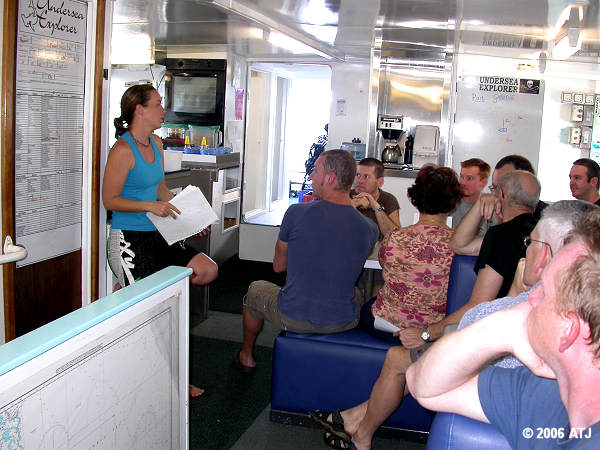
The briefing basically set the rules and guidelines for all the dives on the trip. This was followed by the briefing for our first dive which was at Pixie Gardens at the southern end of Ribbon Reef #10. Clare drew us a site map, something we would get for each dive site.
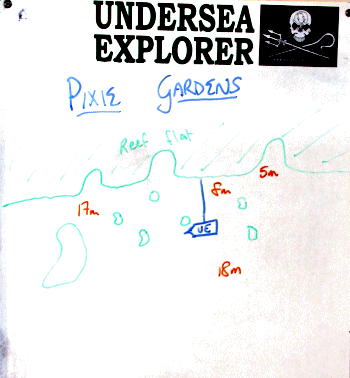
The site was basically a sand area leading up to the edge of the reef flat. There were a large number of large coral boulders for us to check out. (Dive details  << indicates photopgraphs included in dive details) << indicates photopgraphs included in dive details)
After the dive we ate a hearty breakfast and then headed for the next dive site.
On the way to the next dive site, minke whales were spotted in the water. JR stopped the boat and the crew put out two lines: one at the stern and one out from the bow. We put on our snorkelling gear and hung on to the lines. For 30 minutes, while the boat drifted with the current, three whales (one large, one medium and one small) swim around below us, sometimes coming within a few metres. It was a fantastic experience.
The second dive for the day was at Lighthouse Bommie also on Ribbon Reef #10. The bommie is a column which rises from around 25 m of water to around 6 m on top. Next to the column is a slight mound which rises to around 16 m. We started the dive on the mound and then swam across to the column which we circled as we ascended. (Dive details  ) )
While on the dive, Jimmy caught a olive sea snake and brought it back to the boat for us all to see. Jimmy and JR gave us a brief talk on the top deck about sea snakes.
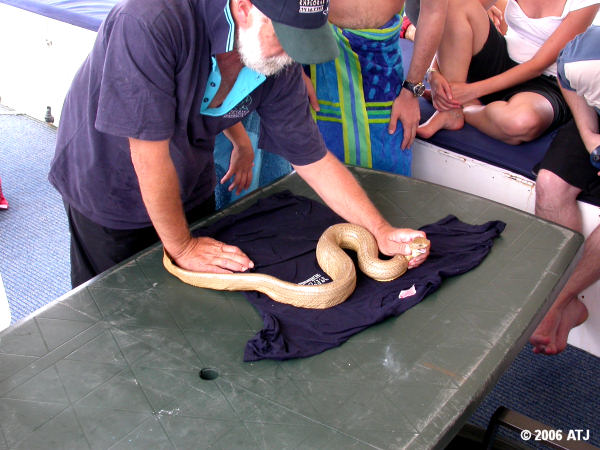
After lunch, Jimmy gave a talk on the species fish and other organisms we should expect to see while diving. Undersea Explorer use the presence or absence of these species to assess the health of the reef.
Our next dive site was Challenger Bay, also on Ribbon Reef #10. The site was similar to Pixie Gardens being a sand flat with coral boulders next to a reef flat. The coral boulders were smaller here and more numerous. (Dive details  ) )
After afternoon tea and a rest, we did our night dive at Challenger Bay. We didn't see anything particularly exciting on the night dive, but I was surprised to see a number of juvenile blue tangs (Paracanthurus hepatus
) asleep in an Acropora sp. colony even though I had not seen any on the dive earlier in the day. (Dive details  ) )
After the dive we had dinner and then headed off to Osprey Reef. With the weather conditions we were experiencing, we only had good conditions for a couple of hours because we were behind and protected by the Ribbon Reefs. Once we headed out to sea, though, it was very rough and those that take drugs to prevent seasickness were advised to take them early.
Day 2: 21 August
After a very rough trip overnight, we arrived at Osprey Reef just before 10 am. Osprey Reef is a sea mount in the Coral Sea some 150 kilometres east of the Great Barrier Reef. The water around the reef drops to 1,000 metres and all dive sites outside the lagoon have steep drop-offs.
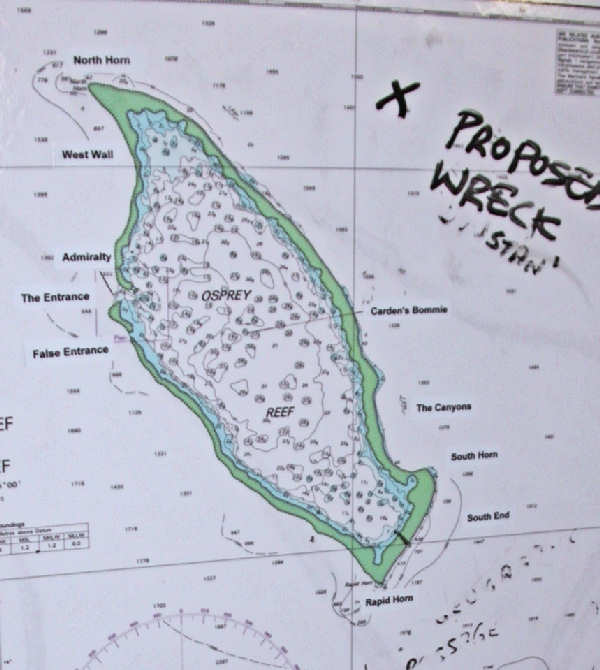
We had a light breakfast and then it was time for our first dive at Osprey, Admiralty Anchor. The site gets its name from a very old style anchor in a swimthrough. (Dive details  ) )
Because we were running so late we had brunch instead of a full breakfast before the second dive which was at North Horn. North Horn is the northern most tip of Osprey Reef. Colin and I headed down the east wall and back again. (Dive details  ) )
Following the dive we had a bit of a snack and Jimmy gave us a talk on sharks and rays, with particular emphasis on the species found around Osprey Reef.
The third dive of the day was a drift dive down the east wall heading towards North Horn. This covered some of the ground that Colin and I had already visited on the earlier dive, but was still interesting. (Dive details)
Before the night dive, Jimmy and a couple of the guests went out to set the Nautilus traps for the night. Undersea have been capturing, measuring, tagging and releasing Nautilus at Osprey Reef for 10 years in an effort to gain more information on these "living fossils".
As we were preparing for the night dive, Mark provided some information on what we might find under the boat after the night dive. He was mostly interested in octopus and squid that may be attracted to the lights.

The night dive was at Admiralty Anchor, the same location as the first dive of the day. The two most interesting aspects of the dive are the basket star that is regularly seen to the south of the cave with the anchor and the flashlight fish inside the cave. Colin and I were unable to locate the basket star but we did get to see the flashlight fish. Basically, we swam into the cave, turned all our lights off and waited for the flashlight fish to appear. They are very cool to see, (Dive details)
We had dinner and then spent much of the rest of the evening looking at Mark and Julian's catch, including juvenile octopus.
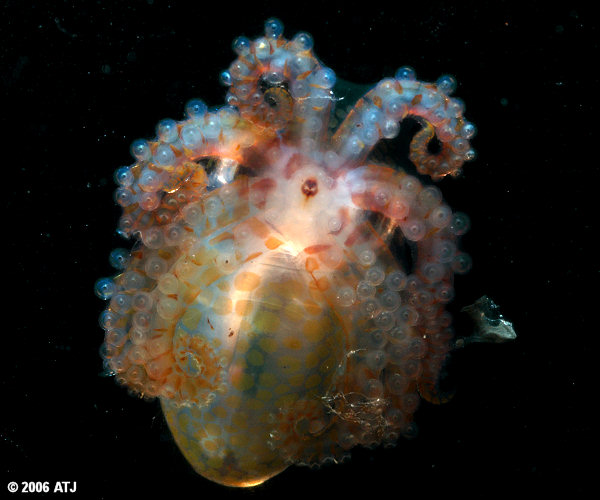
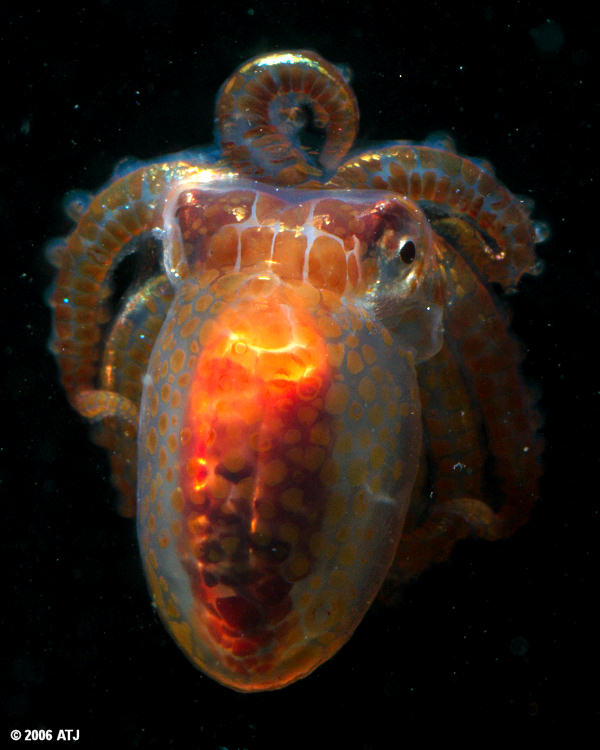
Sleeping on the 3rd night was much easier as we stayed anchored at Admiralty Anchor all night.
Day 3: 22 August
First thing in the morning Jimmy and a couple of guests went out to retrieve the Nautilus traps. One trap had 7 Nautilus but unfortunately they were not able to retrieve the second trap. Traps have been lost previously and some have eventually been retrieved. In each case, one a few months months later , they have never found any dead Nautilus. This suggests they eventually find their way out.
After a light breakfast, the first dive of the day was at Raging Horn. Manta rays are frequently seen at this site and this dive was no exception. We headed out in two groups and each group had their "own" manta ray. (Dive details)
We had a nice hot breakfast and then headed up to the top deck for a talk on Nautilus by Mark and Jimmy and then to measure and engrave the captured Nautilus.
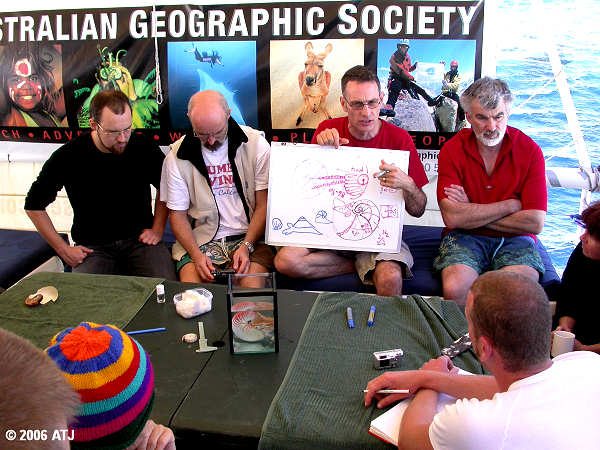
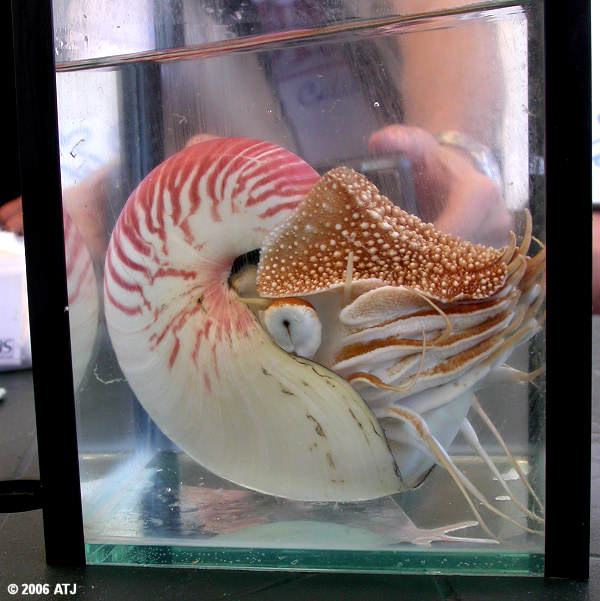
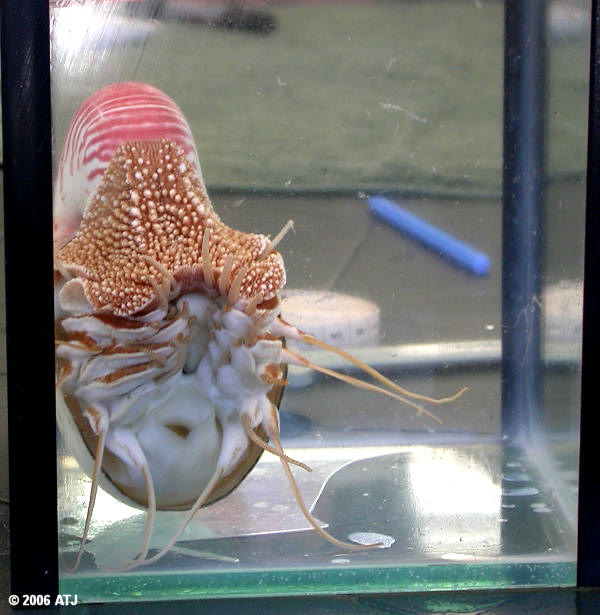
The second dive for the day was the "Shark Attract" at North Horn. This is a regular occurrence on the Undersea trips to Osprey. The crew put fish inside two milk crates tied together and take this down to an area known as "the pulpit". The crates are secured here and this brings sharks in so that everyone (who is lined up around the outside of the pulpit area) can see them closely. This time we had a number of grey reef whalers (Carcharhinus amblyrhynchos
) and whitetip reef sharks (Triaenodon obesus
). (Dive details)
The third dive for the day was a drift dive down the west wall towards North Horn. One feature of the west wall is a large number of soft corals and sea fans, including a large cave covered with sea fans. I also saw a many-banded angelfish, Paracentropyge multifasciata. (Dive details)
JR was waiting at the end of the dive with a Nautilus that we could either photograph, or be photographed with,


The night dive was back at Admiralty Anchor where we had another opportunity to photograph the Nautilus and also to find the basket star. This time we found the basket star, although it was not in the usual place. This might explain why we didn't find it the previous night. (Dive details)
We had to eat dinner quite quickly as we were heading back to the Ribbon Reefs on the Great Barrier Reef overnight. The trip back was nowhere near as rough as the trip out.
Day 4: 23 August
We arrived at Cod Hole just after 7am, had a quick breakfast and it was straight into the water. I have been to the Cod Hole on previous trips but this was the first time I had not seen any potato cod, Epinephelus tukula. (Dive details)
We had a nice hot breakfast and then made the trip to Lizard Island. I have never been to Lizard Island before and, expecting a coral cay, was quite surprised to see a very large island with a lot of rock.
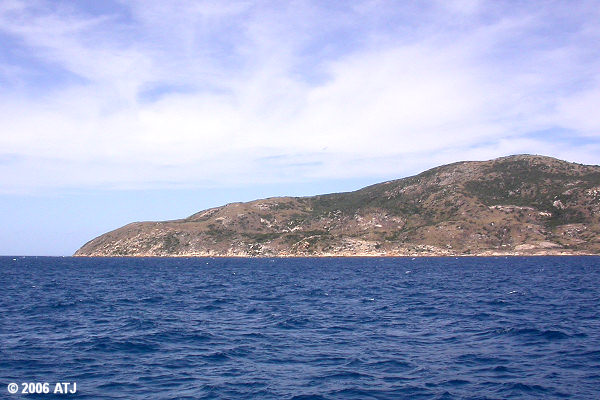


The plan at Lizard was to look for interesting octopus and cuttlefish (e.g. something like Metasepia pfefferi). For this we did a muck dive in Watson's Bay. Mark gave us an introductory talk on what we might find, including these very strange stony corals, Heteropsammia cochlea, that initially settle on shells inhabited by hermit crabs but eventually grow over the shell and then allow a worm to live in the shell. The worm pulls the coral around the bay floor.
The floor of the bay is flat and muddy and we moved very slowly over the bottom looking for interesting organisms. We found the Heteropsammia cochlea very quickly and there were also a number of small fungiids. Gianmarco caught a ghostpipefish, Solenostomus cyanopterus, which was released after being photographed. (Dive details)

After lunch we had a free afternoon. Some people went to the island to have a wander. We wanted to keep our "sea legs" and so went for a snorkel around the edge of Watson's Bay. There was an interesting array of corals and clams in the shallows. There were a large number of colonies of Acropora, Porites and Pocillopora as well as many soft corals, including Sarcophyton and Sinularia. There were also a few colonies of Goniopora. The clams ranged in size from 15cm right up to a Tridacna gigas that was over a metre long.
After the snorkel we went back to the boat for a bit of a frolic, jumping off the top deck until our noses were full of water. Then we went to watch "Doctor Who" on DVD.
The night dive was another muck dive at Watson's Bay. This time it was a little more shallow but much the same. Simon managed to collect an Octopus marginatus. (Dive details)
After the dive we had a barbecue dinner before heading south to Ribbon Reef #3.
Day 5: 24 August
The first dive of the day, after a light breakfast, was Tracy's Wonderland on Ribbon Reef #3. Much like Pixie Gardens and Challenger Bay, this was a sandy bay on the edge of the reef flat. (Dive details)
We had a hot breakfast and then Mark gave us a talk on cephalopods while we were heading for the next dive site.
Temple of Doom was the site for the second dive of the day, This is also on Ribbon Reef #3 and is a large bommie with a flat area on top at around 5 m. (Dive details)
After lunch we dived Steve's Bommie (on Ribbon Reef #3). Steve's is a very popular dive site and for good reason. The diversity of life on this one bommie is truly amazing. It has been said that if something can be found on the GBR, it will be seen here. (Dive details)
In the afternoon, Julian gave a talk about a group of octopuses that have left the sea floor and become pelagic, like there distant ancestors. This groups included the paper nautilus or argonauts, but also some very bizarre animals.
For the night dive we headed back to Tracy's Wonderland. (Dive details)
We had a baked dinner and then watched DVDs on minke whale and shark research performed with Undersea Explorer. The shark research includes tagging of tiger sharks by Richard Fitzpatrick whish is now done on the Remote Far North Expeditions to Raine Island.
Day 6: 25 August
Our final day was spent on Agincourt Reef. The first dive was at Turtle Bommie. This site was similar to Temple of Doom the day before and we swam around the outside of the bommie before heading over the top. On top there were octopus and stone fish. (Dive details)
After breakfast we head to our final dive site, G Spot, another bommie of similar nature to Turtle Bommie and Temple of Doom. This final dive was our one and only live pickup. (Dive details)
After the dive and some lunch, we headed back to Port Douglas. On the way back we went past Low Isles.
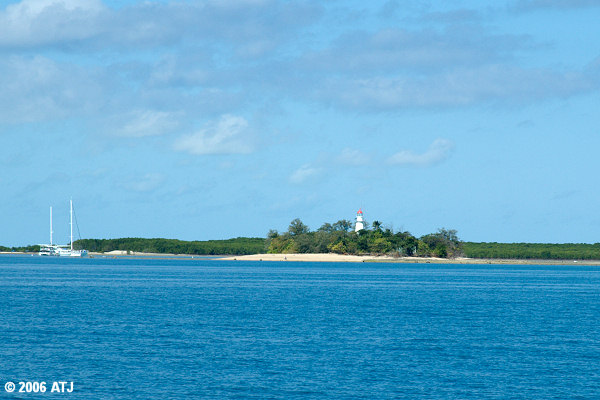
We were delayed for around an hour just short of Port Douglas because the tide was not high enough. This allowed us to spy on some of the very expensive property overlooking the water.
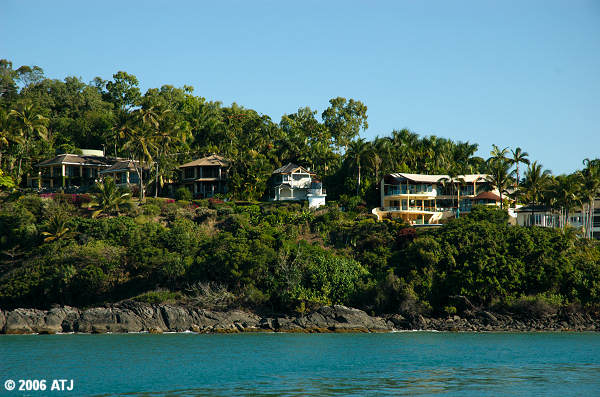
Once we docked and disembarked, our trip was at an end. And what a fantastic trip it was.
Postscript
On one of the dives, we were lucky enough to see some pygmy seahorses, Hippocampus bargibanti. These fish are tiny at around 2 cm tall. They were very hard to see on their sea fan and difficult to photograph.
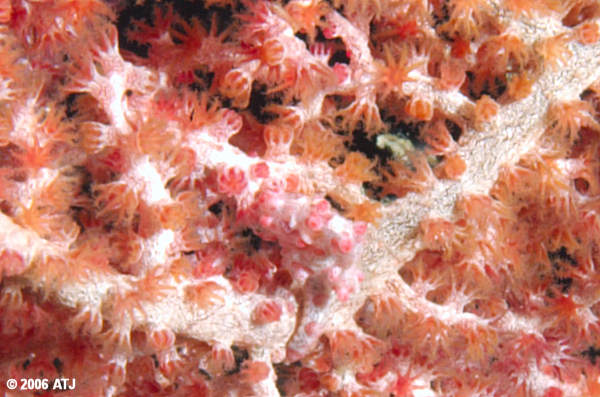
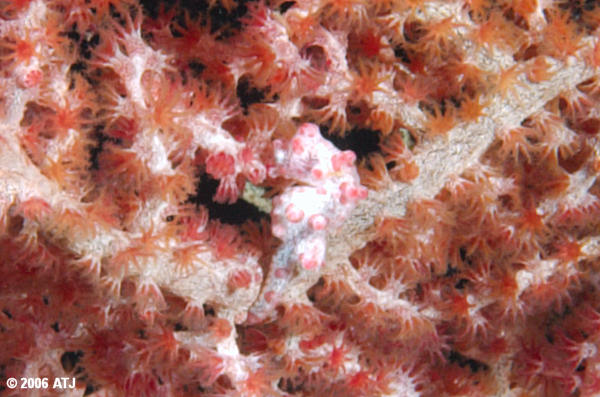

Last updated: 22 March 2007
|
